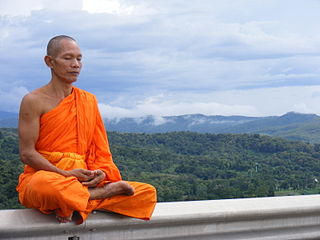
Rebirth in Buddhism refers to its teaching that the actions of a person lead to a new existence after death, in endless cycles called saṃsāra. This cycle is considered to be dukkha, unsatisfactory and painful. The cycle stops only if liberation is achieved by insight and the extinguishing of desire. Rebirth is one of the foundational doctrines of Buddhism, along with Karma, nirvana and moksha.

Satipaṭṭhāna is the establishment or arousing of mindfulness, as part of the Buddhist practices leading to detachment and liberation.

In Buddhism, the Seven Factors of Awakening are:

Āyatana is a Buddhist term that has been translated as "sense base", "sense-media" or "sense sphere." In Buddhism, there are six internal sense bases and six external sense bases.

In Buddhism, dhamma vicaya has been variously translated as the "analysis of qualities," "discrimination of dhammas," "discrimination of states," "investigation of doctrine," and "searching the Truth." This concept implies applying discernment to body-mind phenomena in order to apply right effort, giving way to entry into the first jhana.
Vijñāna (Sanskrit) or viññāṇa (Pāli) is translated as "consciousness," "life force," "mind," or "discernment."
Vedanā is a Buddhist term traditionally translated as either "feeling" or "sensation." In general, vedanā refers to the pleasant, unpleasant and neutral sensations that occur when our internal sense organs come into contact with external sense objects and the associated consciousness.

The Anguttara Nikaya is a Buddhist scripture, the fourth of the five nikayas, or collections, in the Sutta Pitaka, which is one of the "three baskets" that comprise the Pali Tipitaka of Theravada Buddhism. This nikaya consists of several thousand discourses ascribed to the Buddha and his chief disciples arranged in eleven nipatas, or books, according to the number of dhamma items referenced in them.
The Buddhist Publication Society is a charity whose goal is to explain and spread the doctrine of the Buddha. It was founded in Sri Lanka in 1958 by two Sri Lankan Buddhist laymen, A.S. Karunaratna and Richard Abeyasekera, and a European-born Buddhist monk, Nyanaponika Thera. Originally conceived as a limited effort to publish small, affordable books on fundamental Buddhist topics, the Society expanded its scope in response to the reception of their early publishing efforts. Reflecting its Sri Lankan roots, the Buddhist Publication society's publications reflect the perspective of the Theravada branch of Buddhism, drawing heavily from the Pali Canon for source material.

The brahmavihārās are a series of four Buddhist virtues and the meditation practices made to cultivate them. They are also known as the four immeasurables. The Brahma-viharas are:
- loving-kindness or benevolence (metta)
- compassion (karuna)
- empathetic joy (mudita)
- equanimity (upekkha)
Saṅkhāra is a term figuring prominently in Buddhism. The word means 'that which has been put together' and 'that which puts together'.

Bhikkhu Bodhi, born Jeffrey Block, is an American Theravada Buddhist monk, ordained in Sri Lanka and currently teaching in the New York and New Jersey area. He was appointed the second president of the Buddhist Publication Society and has edited and authored several publications grounded in the Theravada Buddhist tradition.

Ekaggatā is a Pali Buddhist term, defined as tranquillity of mind; onepointedness. (Source): BuddhaSasana: Concise Pali-English Dictionary
In Buddhism, bodhipakkhiyā dhammā are qualities (dhammā) conducive or related to (pakkhiya) awakening (bodhi).
Passaddhi is a Pali noun that has been translated as "calmness," "tranquillity," "repose" and "serenity." The associated verb is passambhati.

Skandhas (Sanskrit) or khandhas (Pāḷi) means "heaps, aggregates, collections, groupings". In Buddhism, it refers to the five aggregates of clinging (Pancha-upadanakkhanda), the five bodily and mental factors that take part in the rise of craving and clinging. They are also explained as the five factors that constitute and explain a sentient being’s person and personality, but this is a later interpretation in response to sarvastivadin essentialism.

The Pāli Canon is the standard collection of scriptures in the Theravada Buddhist tradition, as preserved in the Pāli language. It is the most complete extant early Buddhist canon.
Triune Mind, Triune Brain is a theoretical model developed by Canadian Buddhist scholar Suwanda H. J. Sugunasiri. It follows upon his clarification of the three terms used by the Buddha for consciousness, namely, Mano, Citta and Viññāṇa as can be seen in his work on the Triune Mind. Looking into the fields of Pali Buddhism, Neuroscience, Anthropology, Linguistics, and Embryology, among others, the overall thrust of this research moves toward a formalization and scientific refinement, done by assimilating functions of the mind as known in the Sutta and the Abhidamma with structures of the brain according to evolutionary biology.





